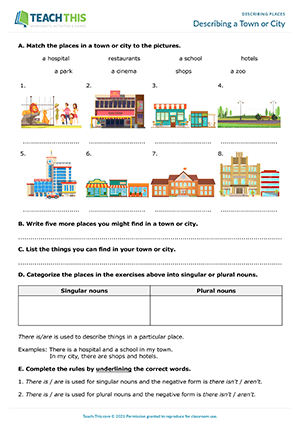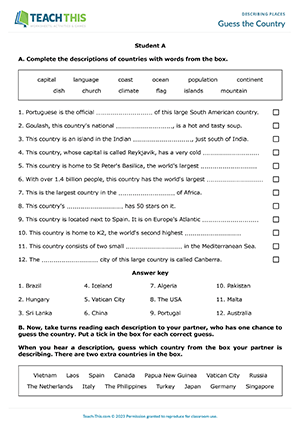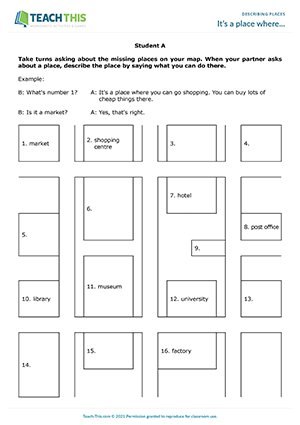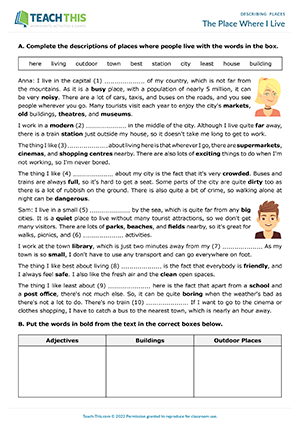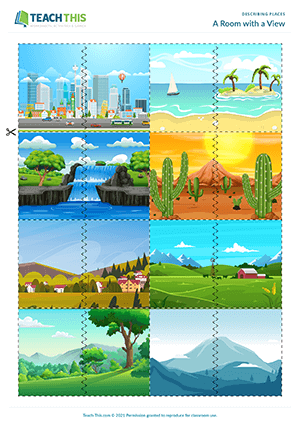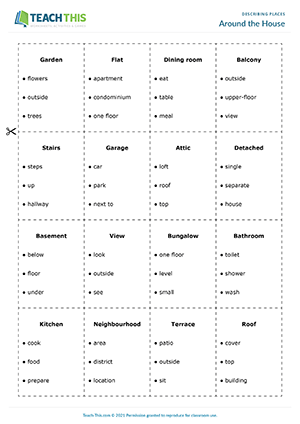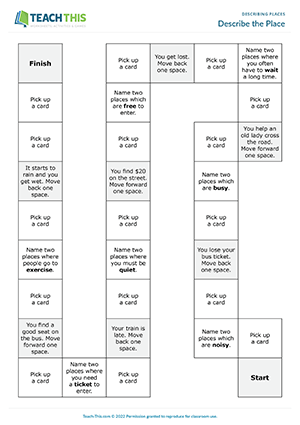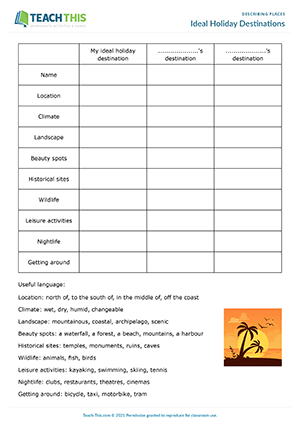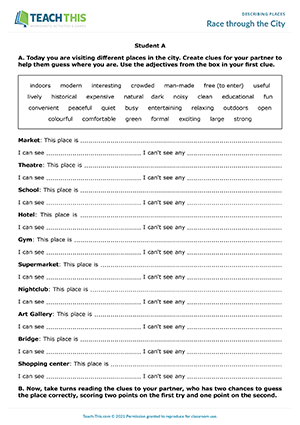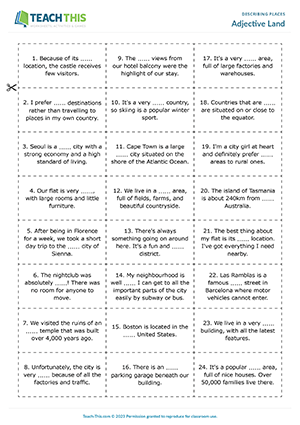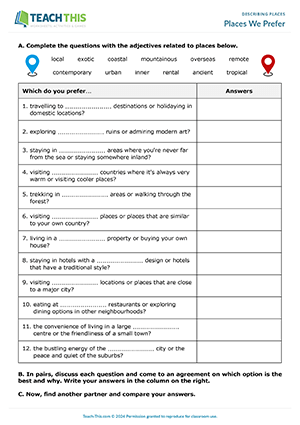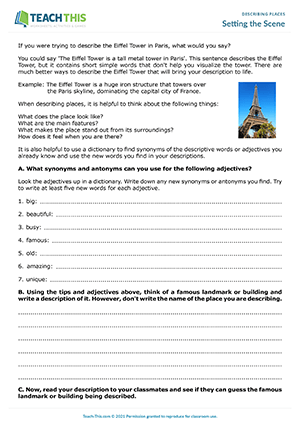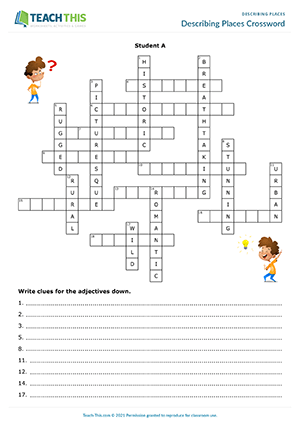In this comprehensive describing a town or city worksheet, students learn and practice how to describe a town or city using singular and plural nouns and There is/are. Students begin by matching nouns to pictures. The nouns are all places you would normally find in a town or city. Students then use their own ideas to write five more things they might find in a town or city, e.g. factories, a train station, etc. Next, students list the things that are in their town or city. Students then move on to categorize the nouns from the exercises into singular and plural nouns. After that, students complete a set of rules on how to use singular and plural nouns with There is/are. Students then practice the grammar rules by reading sentences containing errors in the use of There is/are and correcting the mistakes. In the last exercise, students do a gap-fill exercise where they describe their own town or city and then read their texts to the class.
Here is a useful describing countries game to help students practice vocabulary for describing places. In two groups, students work together to complete descriptions of countries with words from a box. Next, students pair up with someone from the other group. Students then take turns reading out a description to their partner, who chooses a country from a box on their worksheet that they think matches the description. If the country is correct, the student puts a tick in the box next to the sentence. It is then the other student's turn to read out a description. The student with the most correct guesses at the end of the game wins.
In this free describing places speaking activity, students describe places by saying what you can do there. This activity can also be used to practice places in a town. Each student's worksheet contains the same map as their partner, but different places on each map are missing. Students take it in turns to ask about one of the missing places on their map. Their partner then describes the place by saying what you can do there, e.g. 'It's a place where you can meet your friends and drink beer'. The student then guesses what place is being described from their partner’s description. If the student guesses correctly, they write the name of the place on the map. If not, their partner continues to describe the place until the student gets it right. This process continues with students taking it in turns to describe places until all the places have been marked on the two students' maps.
In this productive describing places worksheet, students practice a range of vocabulary and language related to describing places in a town and city. To begin, students read and complete descriptions of places where two people live with the words provided. Students then put words in bold from the descriptions in the correct categories. Next, students review the two descriptions and underline the correct person's name in the sentences. After that, students complete sentences with the prepositions: to, on, in, from, by. Following that, students underline the correct grammatical forms in each sentence. Lastly, students unscramble conversation questions about where they live and then ask and answer them with a partner.
In this engaging describing places activity, students describe a place in a picture to others in order to find someone who has the other part of the picture. Together, the two students then write a description of the place. Students go around describing their picture to various classmates until they find the student who has a matching description. The two students then confirm they have the right person by asking and answering questions about their picture, e.g. 'Are there mountains in your picture?' If the replies are positive, the two students show each other their picture. Next, pairs imagine that they are on holiday in the place in their picture and that the picture shows the view from the room in their holiday accommodation. Pairs then write a description of the view, inventing additional details about the place. Next, each pair exchanges their description with another pair, without saying which picture it refers to. The pairs read the description they have received and match it to one of the pictures on a worksheet and confirm their answer with the other pair.
In this enjoyable describing places game, students describe and guess words connected with houses and buildings. In groups, students take it in turns to pick up a card and describe the word in bold to the other students, without saying any of the words shown on the card or variations of the words. The first student to guess the word being described wins the card. The student with the most cards at the end of the game is the winner.
In this fun describing places board game, students describe places in a town or city for a partner to guess. One member of Team A rolls the dice and moves their counter along the board. If the team lands on a 'Pick up a card' square, one student in the team picks up a card, without showing it to their teammate. The student with the card then describes the place shown in bold to their teammate by completing the three sentences on the card, e.g. 'This place is busy. There are lots of seats. People come here to travel to places far away'. Their teammate then guesses the place being described, e.g. airport. If the student manages to guess the place correctly, they stay on the square. If not, they move back two squares. It is then Team B's turn to play. If the team lands on a 'Name 2' square, they must name two places that fit the description before picking up a card. The first team to reach the 'Finish' square wins the game.
In this free talking about places activity, students describe their ideal holiday destination and find out about their classmates' holiday destinations, discussing which one they would prefer to visit and why. First, students read a passage describing a holiday destination and answer questions about it. Students then make notes about their ideal holiday destination, including information like the location, climate, landscape, historical sites, etc. Next, students take turns asking two classmates about their ideal holiday destinations, making notes on their answers. Afterwards, students find a new partner and discuss which of the six destinations from their two worksheets they would prefer to visit and why. Finally, as a class, students discuss which holiday destinations they liked the most and the similarities and differences between them. As an extension, students create a short promotional talk about their ideal holiday destination, describing it and explaining why it's ideal.
In this imaginative describing places game, students use adjectives to write clues describing different places in a city and then race to describe the places to a partner for them to guess. In two groups, students write clues to describe the places on their worksheet. For the first clue, students use two of the adjectives shown on the worksheet. The other clues describe what the student can and can't see at each place. Students then pair up with someone from the other group. Next, the pairs race against each other to see who can be the first to guess all the places on their partner's worksheet correctly. Students take it in turns to use the clues to describe the places to their partner, putting a tick when their partner guesses the place correctly. The first pair to guess all the places on their partner's worksheet wins.
Here are three describing places games to help students practice adjectives that describe places. First, students play a matching game where they take turns picking up a sentence card, reading it out and placing it face-up. Students then race to find an adjective to match the sentence. The first student to find the right adjective picks up the adjective card and reads out the complete sentence. If the adjective is correct, the student wins and keeps the cards. The student with the most pairs of cards at the end of the game wins. Next, students use the cards to play a pelmanism game where they take turns to turn over one adjective card and one sentence card. If the adjective matches the sentence, the student reads the sentence aloud, keeps the cards, and has another turn. The student with the most pairs of cards at the end wins. After that, students play a describing game with the adjectives. Students take it in turns to pick up a card and make a sentence describing the adjective using the word BLANK for the adjective. Their partner then has one chance to guess the adjective. If the guess is right, the team keeps the card. If not, the other team has one guess to try to steal the adjective. The team with the most cards at the end of the game wins.
In this insightful describing places activity, students discuss their preferences about different places and practice adjectives that describe places. First, students complete Which do you prefer...? questions with adjectives related to places. In pairs, students then discuss each question. After agreeing on which option is the best and why, they write their answers in the column on the right. After that, students pair up with a different partner and compare their answers. Finally, have a feedback session to go over the students' answers as a class.
In this insightful describing places worksheet, students learn adjectives that describe places, famous landmarks and buildings, and practice writing descriptions. First, students write synonyms and antonyms for adjectives using a dictionary. Students then think of a famous landmark or building and write a description of it, without naming the place in their description. Students then take it in turns to read their descriptions to the class who try to guess the famous landmark or building being described. Students then move on to name famous landmarks in pictures, write adjectives to describe them and use the adjectives to write descriptions of the landmarks. Next, students think about the worst place they have ever been to and write down six negative adjectives to describe it. Students then write a description of the place. After that, students write about the same place, but as if they were a travel agent and had to sell it as a holiday destination to tourists using six positive adjectives. Finally, students read out their two descriptions to the class.
In this rewarding describing places crossword activity, students define and guess adjectives that are used to describe places. In two groups, students invent and write down clues for the adjectives written on their crossword. Students then pair up with someone from the other group and take it in turns to ask their partner for a clue to one of their missing words. Their partner reads out the clue for that adjective and the other student tries to guess what it is. If the student guesses the adjective successfully, they write it on their crossword. If not, their partner continues to give more clues until the student is able to guess the word. Lastly, students check their spelling by comparing crosswords.
Latest Free
Resources
- Everyday Objects Bingo
Everyday Objects
Elementary (A1-A2)
- Action Verb Races
Actions
Elementary (A1-A2)
- Birthday Basics
Birthdays
Elementary (A1-A2)
- Sales Phrasal Verbs
Business Phrasal Verbs
Upper-intermediate (B2)
Latest Member
Resources
- Collocations at Work
Business Collocations
Intermediate (B1)
- Etiquette Trivia Board Game
Etiquette and Manners
Upper-intermediate (B2)
- Everyday Objects Vocabulary
Everyday Objects
Pre-intermediate (A2)
- Let's have a talk
Verb-Noun Collocations
Pre-intermediate (A2)



